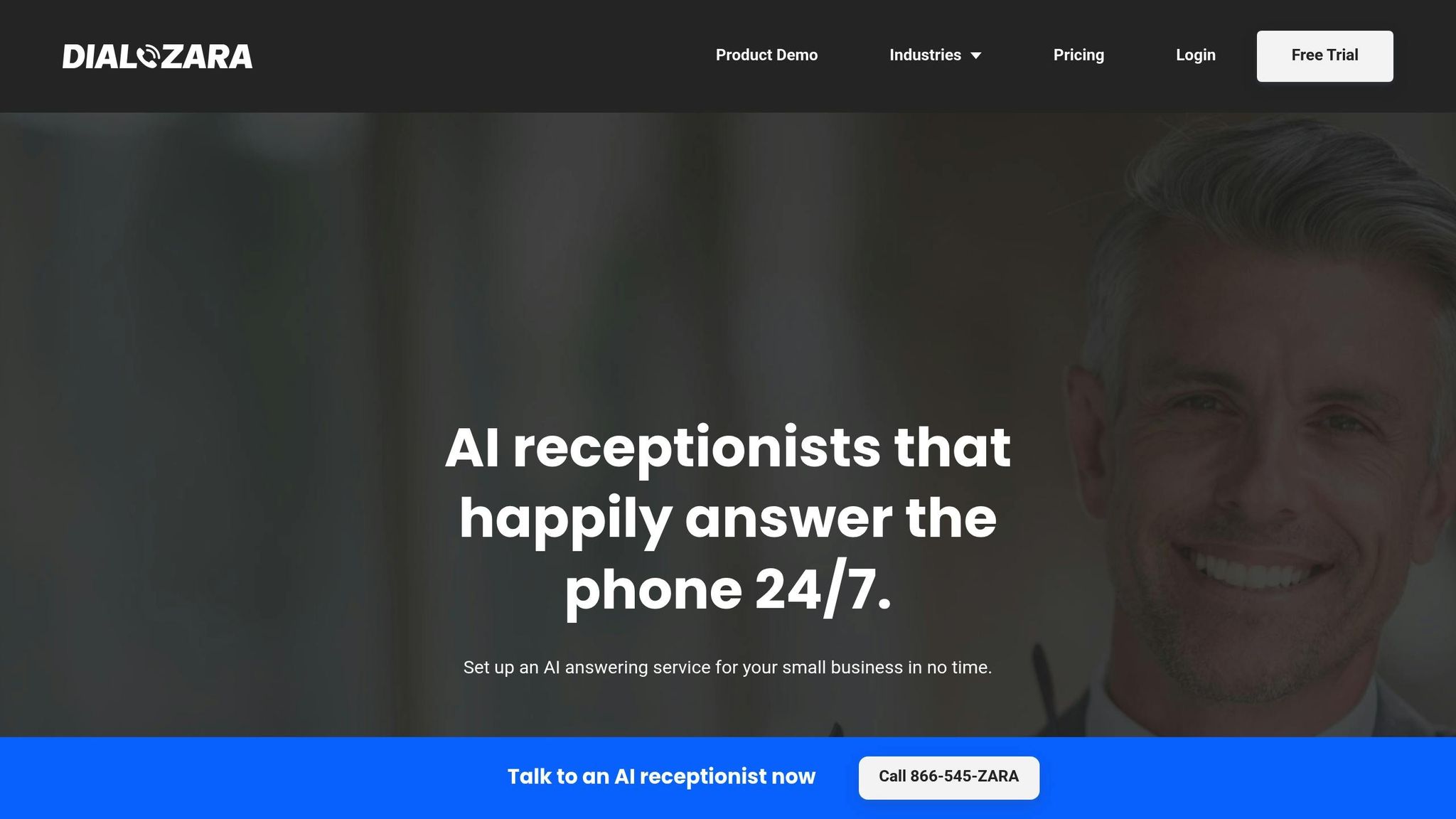
Event-Driven Automation for Customer Service
Did you know that only 38% of calls to local businesses are answered, leaving 62% of customers unheard? Event-driven automation is transforming customer service by using triggers - like calls or inquiries - to activate automated workflows. This ensures 24/7 availability, faster responses, and better resource use.
Key Benefits:
- 24/7 Support: No missed calls, even after hours.
- Efficiency: Automates routine tasks like call routing and follow-ups.
- Scalability: Handles growing call volumes without extra staffing.
- Consistent Quality: Uniform responses reduce errors.
How It Works:
- Detects triggers (e.g., an incoming call).
- Automates actions like answering, collecting data, or scheduling.
- Escalates complex issues to live agents when needed.
Example Tool: Dialzara
An AI virtual receptionist that handles after-hours calls, manages multiple inquiries, and even recognizes caller patterns for tailored responses.
Why It Matters: With automation, businesses can grow without increasing costs, improve customer satisfaction, and free up staff for high-priority tasks.
Start Simple: Automate one task, like after-hours call handling, and refine the system over time. Tools like Dialzara can be set up in under 10 minutes.
TL;DR: Event-driven automation bridges gaps in customer service, ensuring no inquiry goes unanswered while boosting efficiency and scalability.
Main Advantages in Customer Service
Instant Response Capabilities
Event-driven automation enables quick responses to customer inquiries, ensuring continuous interaction. This helps bridge a critical service gap in customer support.
"I'm very pleased with your service. Your virtual receptionist has done a remarkable job, and I've even recommended Dialzara to other business owners and colleagues because of my positive experience." - Derek Stroup
By addressing inquiries instantly, businesses can better allocate their human resources to tasks that require personal attention.
Improved Team Efficiency
Automation improves team productivity by handling routine tasks like basic inquiries, call routing, data collection, and follow-ups. This allows customer service agents to focus on more complex and high-value issues.
| Task Type | Benefit of Automation |
|---|---|
| Basic Inquiries | Quickly resolves common questions and requests |
| Call Routing | Directs calls to the right departments or individuals |
| Data Collection | Automatically gathers and organizes customer details |
| Follow-ups | Ensures consistent and timely follow-up actions |
"I've found Dialzara to be incredibly efficient and authentic." - Bobby James Fournier
Growth Without Added Costs
Automation not only improves responsiveness and efficiency but also supports business growth without increasing expenses. Companies can handle more customer interactions and higher call volumes while staying within budget. This is made possible by several factors:
- 24/7 availability without the need for overtime pay
- Reliable performance that doesn’t fluctuate
- Continuous improvement as systems learn and adapt over time
- Efficient resource use by automating repetitive tasks, reducing the need for extra staff
This approach is especially helpful for small businesses, where making the most of available resources is essential for scaling up.
Setting Up Event-Driven Automation
Finding Tasks to Automate
Look at your operations to identify tasks that consume time and resources. These are often repetitive, predictable, or occur outside regular working hours. Common examples include:
- Repetitive customer inquiries with clear patterns
- After-hours support needs
- Collecting basic information
- Handling simple support requests
- Call routing and scheduling
Once you've identified these tasks, the next step is finding the right tools to handle them efficiently.
Choosing Automation Tools
Pick tools that align with your needs and can grow alongside your business. Evaluate options based on how quickly they can be implemented, how easy they are to use, and whether they integrate with your current systems.
| Factor | Why It Matters |
|---|---|
| Setup Time | Faster deployment minimizes interruptions to your operations |
| Learning Curve | Simplifies adoption for your team, speeding up implementation |
| Integration | Ensures smooth workflows by connecting with existing systems |
| Scalability | Manages increasing customer demands without extra costs |
| Support | Reliable assistance keeps things running smoothly |
For phone system automation, Dialzara is a great example. It offers a setup process that takes less than 10 minutes, with live support available from 8 AM to 8 PM Mountain Time. This makes it easy to implement automation quickly while still having access to help when you need it.
Testing and Improvement
After rolling out automation, keep refining it by tracking how well it performs. Here's how to do it:
- Start with a small, manageable scope
- Measure response times and resolution rates
- Gather feedback from both customers and staff
- Use the data to fine-tune workflows
Modern AI-powered tools can also improve over time by learning from interactions. You can enhance their accuracy by uploading key resources like call scripts, documentation, and website content.
"I've found Dialzara to be incredibly efficient and authentic." - Bobby James Fournier
sbb-itb-ef0082b
Customer Service Automation Examples
Phone System Automation with Dialzara

Modern phone systems have changed how businesses handle customer calls. With many customers preferring direct calls, automated solutions like Dialzara's AI virtual receptionist fill key gaps in phone support. Here's how Dialzara uses event-driven automation to streamline operations:
- Handles after-hours calls seamlessly
- Manages multiple simultaneous calls effectively
- Recognizes caller patterns for tailored responses
- Automates information collection to save time
- Schedules appointments without human intervention
These features ensure smooth service delivery while boosting efficiency. Beyond phone calls, event-driven automation helps tackle issues proactively across various service channels.
Early Problem Detection
Automated systems don't just handle calls - they also monitor and respond to potential issues, improving service quality. Diego Kogutek, a real estate professional, shared his experience:
"When someone tried making a verbal contract with my AI receptionist for a house at an illogical price, the AI handled it well by stating that it couldn't proceed with such a request. It was a moment that not only saved me from potential trouble but also showcased the responsible limitations and reliability of your system. This experience has certainly added a layer of trust and confidence in using Dialzara for our operations."
Here's how early detection makes a difference:
| Detection Area | Business Impact |
|---|---|
| Unusual Requests | Helps avoid fraud or misunderstandings |
| Pattern Recognition | Flags recurring issues that need attention |
| Service Disruptions | Alerts staff before customers notice problems |
| Peak Load Times | Allocates resources more effectively |
Automated Support Escalation
Combining automation with human expertise ensures smooth support escalation. Juan, owner of AllyzAuto, summed it up best:
"One of the best return on investments I've ever made!"
Dialzara uses smart triggers to transfer calls to live agents when necessary, such as:
- Complex or detailed inquiries
- Signs of customer frustration
- Calls from high-priority clients
- Specific keywords signaling urgency
- Time-sensitive requests
This approach balances automation with personal service, ensuring resources are used wisely while keeping customers satisfied.
Conclusion
Key Takeaways
Event-driven automation ensures businesses can provide consistent, around-the-clock customer service. This approach bridges the gaps left by traditional support methods. For instance, while 60% of customers prefer calling local businesses, only 38% of these calls are answered. Automation steps in to address this gap effectively.
AI-driven tools like Dialzara offer small businesses clear advantages:
| Advantage | Description |
|---|---|
| 24/7 Service | Ensures no calls are missed, even during off-hours. |
| Efficient Use of Resources | Handles multiple calls at once without extra staffing. |
| Consistent Quality | Maintains uniform service across all interactions. |
| Cost Reduction | Lowers operational costs while enhancing service. |
| Smart Escalation | Directs complex issues to human agents automatically. |
How to Get Started
Small businesses can follow these steps to integrate automation into their customer service:
-
Evaluate Your Current Setup
Review your call patterns to identify peak times and areas where automation can have the most impact. -
Start with One Feature
Begin by automating a single aspect, such as after-hours call handling. Many AI receptionist services can be set up in under 10 minutes. -
Tailor the System
Adjust the automation to fit your specific needs, ensuring it enhances your overall customer service.
FAQs
How can event-driven automation enhance customer service while keeping staffing costs low?
Event-driven automation streamlines customer service by automating tasks that are triggered by specific actions, such as an incoming call or customer request. This eliminates the need to hire additional staff, as automated systems can handle routine tasks like answering calls, transferring them, or gathering customer information efficiently and consistently.
For example, Dialzara's AI virtual receptionist operates 24/7, ensuring timely responses to customer inquiries while reducing the workload on your team. By taking care of repetitive tasks, it allows your staff to focus on more complex or high-value interactions, improving overall service quality without increasing operational costs. This approach not only boosts customer satisfaction but also helps businesses manage growing demands without additional expenses.
How can small businesses get started with event-driven automation for customer service?
To begin implementing event-driven automation in customer service, small businesses can follow a few simple steps. First, create an account and provide key details about your business to train your AI phone agent. Next, select a voice and assign a phone number to your agent. Finally, set up call forwarding to ensure incoming calls are directed to your AI receptionist. With this setup, your business can start automating customer interactions seamlessly and efficiently.
How does Dialzara maintain high-quality service while managing complex customer inquiries?
Dialzara ensures top-notch service by using AI-powered virtual agents that are available 24/7, eliminating the challenges of human limitations like fatigue or availability. These agents are specifically trained to understand industry-specific terminology and adapt to your business’s unique communication style, ensuring accurate and professional interactions with every customer.
With the ability to integrate seamlessly with over 5,000 business applications, Dialzara streamlines workflows and handles tasks like call transfers, client intake, and appointment scheduling effortlessly. Its quick setup and intuitive design make it easy for businesses to deploy, providing consistent, high-quality support for even the most complex customer needs.
Related Posts
AI Event Triggers for Customer Messaging
Learn how AI event triggers can automate customer messaging, boost engagement, and reduce service costs for businesses.
How AI Reduces Call Wait Times
Explore how AI is revolutionizing customer service by significantly reducing call wait times and enhancing operational efficiency.
How AI Prioritizes Customer Calls
AI enhances call management for businesses by prioritizing urgent calls and reducing wait times, improving customer service and operational efficiency.
How AI Ensures 24/7 Customer Service Availability
Explore how AI enhances customer service with 24/7 availability, improved experiences, and seamless integration into business operations.
